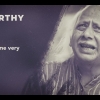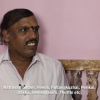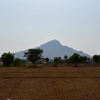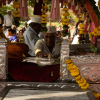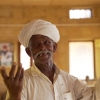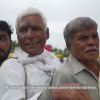Sudha Gopalakrishnan: Thank you, Dr Virginie Johan for agreeing to come and talk for us, for Sahapedia. To introduce Virginie, she has been a very avid scholar and practitioner of Kutiyattam. She has been coming to India for the last 20 years and has engaged with all the practitioners here and all the texts and has also taken a PhD now in Kutiyattam. She has just secured her PhD. And she still continues with the art form not just as a side occupation but as a serious profession and she has been a very committed scholar all these years. So I would like to ask her some questions about what made her take up Kutiyattam. What was your engagement with Kutiyattam?
So to start with this conversation, how did you get interested in Kutiyattam? Did you happen to see it in your country or was it because you came to Kerala? How did it happen and what was the inspiration for you?
Virginie Johan: Well, I have always been interested in epics─the Mahabharata and the Ramayana. I was interested even in our French epics and the Greek epics. I started to read the epics early. Then when I went to university, I took Performance Studies and then I took some classes in Indian Studies also. Then I became more and more interested in the Ramayana. When I went in my Masters degree, at that time I wanted to make a Masters degree about the Ramayana performance in India. It was a huge subject. But at that time fortunately Kutiyattam came to Paris.
In fact, Milena Salvini made this group in 1998. It was the second Kutiyattam tour to France.
S.G.: Where was this performed?
V.J.: The Kalamandalam group came for two months and they performed in Theatre de Soleil and Rama Chakyar who became at that time my guru gave a workshop for one month in a place called ARTA, Association for Theatre Research, a tradition of theatre research. And so I attended this workshop and it was where I found my asan (guru/teacher). We became close.
S.G.: Painkulam Rama Chakyar?
V.J.: No. Rama Chakyar Junior. And secondly, I felt very interested in Kutiyattam. I did my Masters only in it. And three days after that I came to India for nine months and stayed in Kerala. I started studying Kutiyattam.
S.G.: At that time were you with Kalamandalam or were you with some other institution or was this your first association starting with Kalamandalam?
V.J.: Yes, it started with an ICCR Research Scholarship in Kalamandalam itself.
S.G.: And was that for practising or was it for research?
V.J.: No, it was for research.
S.G.: How did you start your research? What is the topic of your research?
V.J.: Well, I came and I applied to ICCR with a Ramayana project, Ramayanasamkshepa. But in fact when I came, my first questions were about the Chakyar’s families. So I made an anthropological research on Chakyar families for nine months. And so that is how I met all these people and made the family trees.
S.G.: Yes, you made a wonderful family tree of the Chakyar families which I think is still relevant and for research for anything to do with deeper probing.
V.J.: Thank you. At that time, it was very interesting because they followed marumakkathayam, the matrilineal system. Now it is changing. But the Chakyar families were following the marumakkathayam when I started my research.
S.G.: Which year was this?
V.J.: I was doing research through the years 1998, 1999, 2000. Then it was really marumakkathayam everywhere.
S.G.: That the knowledge was going from uncle to nephew, that kind of lineage and not from father to son.
V.J.: Yes. Since 2005-2006 it has been slowly changing. But through the whole 20th century we had great evolution in the Chakyar families, great evolution in marriages. First it was the Chakyar women—they married Namboodiris, then they married Chakyars, then they married Nambiars. Now even a Chakyar can marry a Pothuval. So it is changing, it has changed a lot and that was very interesting to study.
S.G.: But you confined your study to the Chakyar families because now right from the 1970s even non-Chakyar actors used to come into the Kutiyattam stage which is a great transformation actually including Siva Namboodiri and many other people who have come later also. So what do you say to that? I mean, are they also included in your lineage tree?
V.J.: No, they are not included in my lineage tree because they are not Chakyars. I focussed on Chakyars because I wanted to know who my guru was. I wanted to know who his uncle was. He was always talking to me about his ammavan (uncle). And I wanted to know who was his grand uncle. And I wanted to know this great master who wrote Attaprakaram. So my research was confined to Chakyar families basically.
Now of course since the 1980s, since 1965, my asan’s uncle, since Painkulam Rama Chakyar we have non-Chakyars performing and great actors like Sooraj Nambiar in Iranjalakkuda who is totally amazing. Also I had for teacher of course Girija Devi in Kalamandalam who is an amazing actress.
So they are not included in the Chakyar lineage but they are included in the Kutiyattam families and they cannot perform in the temple, that’s all. And at that time when I started studying it, the full performance with purappadu, nirvahanam (retrospection) etc. was only done in the temple. Venu ji (G. Venu), who is a non-Chakyar but did so much for Kutiyattam, was starting to do it in his institution Natanakairali at Irinjalakkuda. He was starting to show the full performance. But when I started my research if we wanted to see the full Kutiyattam, we had to become Hindu.
S.G.: So you had to convert yourself.
V.J.: Yes, that is the first thing I did when I came. The first thing I did because I wanted to see Kutiyattam and it was performed only in temples except for the festival at Irinjalakkuda.
S.G.: So from Virginie you became Varshini.
V.J.: Yes, at that time.
S.G.: To go back to the lineage tree, how far back could you go with the Chakyar families?
V.J.: Well, I did good work on the Painkulam family because my asan belonged to it. So I worked a lot on it. And Painkulam Sharada Illottama who recently died helped me. Painkulam Narayana Chakyar said that she was the computer of the family and she knew all the details. So we could go back, I think, nine generations.
S.G.: You went for about nine generations back?
V.J.: Yes.
S.G.: That is remarkable.
V.J.: Yes, nine generations. That is the biggest one.
S.G.: So you took the Painkulam branch of the Chakyars? What about the Ammannur and the other traditions, I mean those families which are really not now, atleast if not extinct, not in the performing mode. For example, there are many Chakyars who have not taken up Kutiyattam as a practice and so to that extent those families are not in the ambit. So have you taken such people also?
V.J.: Yes, I made the family trees of the Chakyar families—Painkulam, Ammannur, Pothiyil, Kuttanchery, Kitangur and Mani. And there is one more Chakyar family but there is no performer in it. So there are totally seven families. Only six are still in the performing field.
S.G.: Also you can trace them back to their ancestors?
V.J.: Yes, but not for nine generations. Maybe only for four generations back. For the Kuttanchery family tree there is a break. Sangeeth Kuttanchery is the only performer since many generations. So for the Kuttanchery family, maybe I have traced five generations and then I have some ancestors from very early generations. We don’t have the link between.
S.G.: Even so what you did, I think, is very significant for the history of Kutiyattam. But what was your research topic?
V.J.: My research in fact is about the epic embodiments and epic distancing processes in Kutiyattam. It is very well seen in Anguliyankam and also you spoke this morning about this. Anguliyankam is very complex with all these embodiments—how Kutiyattam embodies stories in the drama and how it embodies story in the story in the story in the story in the story. This is the first, I would say, dramaturgy textural point. But then also, in the actor’s way of acting, in the pakarnnattam (role transformation) technique, it is exactly the same because of what the actor does. Stop the time, change the point of view, and to change the point of view he just goes back a little bit to the past to recreate a simultaneity effect because he is acting alone. I mean he is using story-teller techniques. So the acting is in fact ‘complexifying’ the textural dramaturgy. The actor has different faces like Brahma. He can be the dancer who is doing the kriyas which are ritualistic in Kutiyattam. The dance is ritualistic; it is not emotional in Kutiyattam. There is the Sutan, the ritual of doing the nirvahanam and there is the vesham, the character. And then there is the actor himself. If he has a problem with the headgear he will just hide himself. If he has, he will go to the backstage and he will have a tea or put the headgear properly. At that time I am facing the stage which is empty. I can see the actor even if the stage is empty because the actor is always mastering his performance. He can do whatever he wants and he is always here even if the stage is empty because he is in the backstage doing something what he wants.
So this type of distancing processes where you feel always, for example, when he is doing the koothu villakkuka, he is stopping the drum. Rama cannot stop the drum.
S.G.: This has been a constant question to me also, why for example, I thought the distinction between the actor and the character. For example, why is Arjuna taking the stool and putting it onto the stage. Doesn’t it create a kind of discord in your aesthetic sensibility? Actually it does not for exactly the reason that you said. The presence is there and you are looking not so much on those kind of aspects but we are looking at the essence of what he represents rather than…So I think that distinction you just now made, even if the actor is out of the stage, he is there as an invisible presence and that is what you are relating to, not as his physical form. So I think that is right absolutely.
V.J.: Sometimes the actor is also very visible, as you say, when he is taking the stool, he is very visible. The actor is still there behind the curtain. And there is one point very interesting is that the first role to be performed in Kutiyattam is the one of Sutradharan. Sutradharan is an actor. Even if he is not becoming an actor afterwards, every Chakyar from all Chakyar families must do his arangettam (maiden performance) and for this he must perform Sutradharan’s Purappadu from Balacharitam. And who is Sutradharan? Sutradharan is an actor. And during this Purappadu he is saying ‘I am going to the stage. This is attam.’ He gestures that he has come to the stage and will perform and he salutes the Brahmins and then he starts a short portion.
So the first role to be performed is the one of the actor. And then only the Chakyar can have his Upanayanam (compulsory ritual of initiation into the community).
S.G.: Yes, the rites of passage, so to say.
V.J.: Yes. And then he can also learn some other roles, if he becomes an actor or if he has an uncle or father who is an actor, then he can learn Kutiyattam or not. So that is his first role. Sutradharan also makes the actor’s presence very strong. And maybe this is one of the keys of Kutiyattam. Distancing process is everywhere in theatre but in Kutiyattam it is very strong.
S.G.: It is much more. It is in different layers. Actually I also feel that it is deliberately, you are seeing the actor and the character as two. There is no way that it is trying to merge, that they are trying to create an illusion that he is so and so. He is Madhu (Margi Madhu) doing/interpreting such and such a character. He is Madhu interpreting Ravana.
V.J.: But Madhu and the actor are something different. Madhu is a social being. The actor is not the social being.
S.G.: Very true. Yes. And Ravana is different. And of course when it comes to Ravana, he can impersonate in any role. He can do any. So it is such a layered performance, Kutiyattam.
V.J.: Many layers. But your question, I mean your remark, is very difficult because of course there are some great actors like Madhu we are talking about but I was thinking also about Ammannur Madhava Chakyar. Sometimes of course, Sudhaji, they are merging together. The actor and the role are one.
S.G.: Yes. I was going to ask you, what was your experience with Ammannur Madhava Chakyar?
V.J.: He was really the best actor I ever saw in my life. He was totally amazing. It was the greatest theatre experience I ever had. I saw him perform several times he was doing Parvati Viraham and he was acting as Parvati, the bhava traya—the three bhavas (emotions). And in that I really understood Kutiyattam. I understood Kutiyattam.
S.G.: Parvati, the sadness for leaving and anger at Ganga and all that. That is what he meant by the bhava traya. And love for Shiva. All the three coming together. Sadness at leaving, love for Shiva and anger at Ganga.
V.J.: Yes, they say like this but when I was looking at him, I was really feeling that these three feelings were coming together in Parvati’s heart. She was feeling this and the learned spectator could make the time stop. It was not just me. That was a great performance, full of rasa and everyone was like this and we were just stuck there. That was the most powerful performance I ever saw in my life. In my PhD, the 12th and 13th chapters are about Guruji and what the new type of distancing process meant for him. How he was able to break the frontier between reality and theatre. For example, if he was performing the two maids adoring the mistress, he was watching the audience and saying, Come with me to the garden and he was breaking the distance between the stage and the reality. He was an amazing actor. We call it in France ‘acteur hors pair’, meaning there is no comparison.
S.G.: Beyond compare so to say. So happy that you have shared your experience with Ammannur Madhava Chakyar. But also tell me, you also worked very closely with stalwarts like L.S.Rajagopalan. So could you also share that experience with us just like you said just now. What was your study with him? How did you…
V.J.: First of all, I would like to pay homage to my guru who is Rama Chakyar Junior. He is the one without whom nothing would have happened. And L.S. Rajagopalan was my second guru I would say. Rama Chakyar Asan was my guru in everything. I lived near L.S.Rajagopalan's house when I was in Thrissur. And he was my guru in my research. So he was the one who told me, you must become a Hindu, you must get your certificate and you go to Calicut and you do your Arya Samaj rituals.
He was the one also who helped me to choose the play I had to work on. So I chose the five Ramayana acts which are performed in….Surpanakhangam, Balivadham, Asokavanikankam, Ankuliyankam and Thoranayudham. He was the one who made me read all that I had to read.
S.G.: He led you through your research.
V.J.: Yes. He was my research director here in Kerala I could say.
S.G.: And you learnt Malayalam by then? Were you able to read Malayalam by then?
V.J.: I can read Malayalam, I can read Attaprakaram but I am a very bad Malayalam speaker I would say. Now I just completed my PhD in May, so it is a 1600-page PhD, it is a big one. Usually in France we finish the PhD in eight years’ maximum. So I took double time because Kutiyattam is very complex.
You asked me why you went inside Kutiyattam. I mean because it was very difficult. Because it was very complex, because I did not understood nothing, because I wanted to understand. So I focussed on it. And also what I wanted is all this distancing processes. We have so many types of distancing processes. I just spoke about one but there are many, many. Not just one or two but so many different types.
S.G.: I would request you to translate at least some major portions of it into English for more accessibility for people like us who have not had the advantage of learning French. But I believe that a lot of good work has happened in French in the Indian and specifically Kerala culture, quite a few research has focussed around Kerala in French. But having said that I think it will be very beneficial if you could share some of it in English as well. Wish you all the best in your future endeavours also. Thank you so much.
V.J.: Thank you for inviting me.
S.G.: Really appreciate your time and your passion. Thank you so much.







